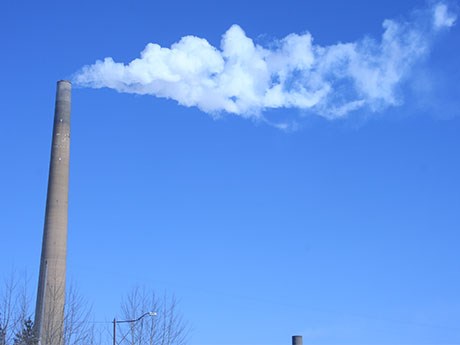Study underway to decide on future of city landmark
Sudbury’s 1250-foot (380-metre) Superstack, the tallest smokestack in the Western Hemisphere and the second tallest freestanding structure in Canada, has outlived its usefulness and could be slated for demolition due to a dramatic decrease in SO2 emissions from Vale’s smelter.
Built in 1970 when the smelter was emitting two million tonnes of sulphur dioxide every year, the stack has become a relic of Sudbury’s pollution scarred past. Today, the smelter emits approximately 150,000 tonnes of SO2 a year, and once the company’s current $1 billion Clean AER (atmospheric emissions reduction) project is complete, emissions will be reduced to between 25,000 and 35,000 tonnes a year. The fate of the stack will be decided by the first half of this year, said Clean AER project director Dave Stefanuto.
“A lot of the legwork has been done. We’re just in the process of finalizing information, doing some validation of the study work and communicating it internally to company executives in the context of our overall business plan.”
The Superstack has become increasingly more expensive to operate and maintain because of the reduced volume of emissions, explained Stefanuto.
“It was designed for two milliontonnes of SO2, so there was a lot of draft – a lot of hot air coming up because of all the converters and flash furnaces we used to run in the 70s.
As emissions dropped, we still had to maintain that draft and heat to prevent condensation from corroding the steel liner.
That necessitated the installation of very large natural gas burners in the flues to drive hot air up the stack.”
That together with the cost of annually replacing sections of the steel liner and patching the concrete shell costs millions of dollars a year, said Stefanuto.
The Superstack is 115-feet wide at its base and 52-feet wide at its summit. It consists of a concrete shell measuring approximately three feet wide at the base and approximately one foot wide at the top. Inside the shell is a 45-foot diameter steel liner. In the space between the shell and the steel liner, there’s a staircase and lifting system to take men and material to the top of the stack for repair and maintenance.
Should a decision be made to do away with the stack, it likely won’t be torn down right away, said Stefanuto.
That’s a huge project in itself that could take three or four years and require the expertise of a company specializing in the removal of large stacks.
“At some point, that stack will have to come down like any physical asset that outlives its usefulness. Whether it’s in 10, 15 or 20 years, I don’t know, but when it happens it will be done in pieces starting from the top. They’ll take a bit off, drop it down the middle and work their way down safely and in a controlled manner.”
Instead of the Superstack, Vale is looking at two new, fit-for-purpose stacks that will perform better and more cost-efficiently from a maintenance and operating perspective. The proposed new stacks will be significantly smaller and closer to the source of the process gases.
One will be for hot gases and the other for cold gases.
By not mixing the two, we can maintain the temperature of the hot gases so we don’t have to burn natural gas,” said Stefanuto.
The study also looked at the possibility of extending the life of the Superstack by installing a series of pie-shaped specialty steel plates to reduce the diameter of the opening at the top.
However, hoisting these large panels to a height of 1250 feet, welding them in place and completing the work during a scheduled three-week maintenance shutdown was deemed to be overly challenging.
“When you start adding everything up, there are just too many risks, so we said maybe we need to look at something new,” said Stefanuto, The Clean AER project that will reduce emissions to somewhere around 30,000 tonnes is scheduled for completion in 2019. So far, one converter has been replaced and work on a second one is in progress. The converters take matte from the flash furnace and remove the sulphur. Sometime in 2016, work will begin on a wet gas cleaning plant to cool and clean the gases from the two converters and send them to Vale’s acid plant.
A third converter will then be replaced and the gas from it diverted from the stack.



